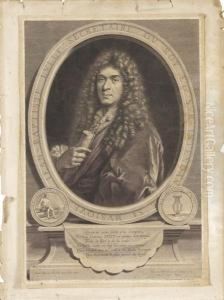Jean Louis Roullet Paintings
Jean Louis Roullet was a French artist known for his contributions as a miniaturist during the late 18th century and early 19th century. Born in 1743 in France, Roullet developed his artistic skills during a period that was rich in cultural transformations, including the Rococo style, which preceded the Neoclassicism that dominated his later years. Despite the political turmoils of the French Revolution and the Napoleonic Wars, Roullet managed to establish a career that reflected the tastes and aesthetics of his time.
Roullet's works are characterized by their delicate execution and attention to detail, which was typical of miniaturists of the era. He worked primarily in portraiture, capturing the likeness of his subjects with a level of detail that could only be achieved through the painstaking techniques of miniature painting. These portraits were often set in ivory, an expensive material that denoted the status of the sitter and the luxury of the art form.
Throughout his career, Roullet exhibited at the Paris Salon, which was the official art exhibition of the Académie des Beaux-Arts in Paris. His works were well-received, and he gained a reputation for his meticulous portraits. As was common among artists of his time, Roullet's clientele included members of the aristocracy and the burgeoning bourgeoisie who desired to have their likenesses captured as a symbol of their social standing.
Jean Louis Roullet's career spanned a tumultuous period in French history. His ability to adapt to the changing artistic tastes of the time, from the ornate Rococo to the more restrained Neoclassical style, allowed him to maintain relevance in the art world. Despite the upheavals of the time, he continued to find patrons for his miniatures, and his work remains a testament to the enduring appeal of portraiture and the skill of miniature painters of the period.
Roullet died in 1806, leaving behind a legacy of finely crafted miniature portraits that provide insight into the fashions and faces of his time. While not as widely known as some of his contemporaries, his work is appreciated by art historians and collectors for its technical skill and historical significance. His miniatures are held in various art collections and continue to be studied for their contribution to the art of miniature painting.
